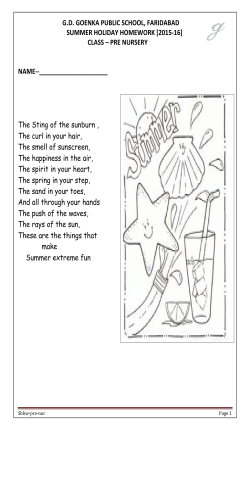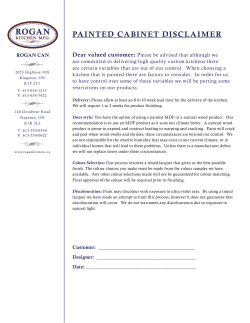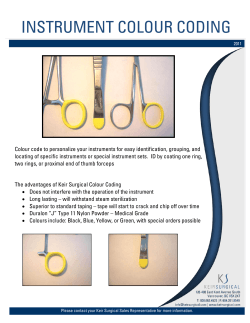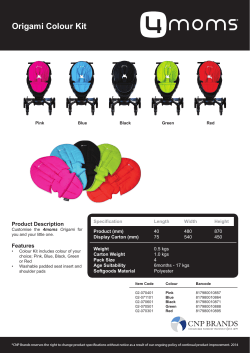
General Rules & Information for Flower Show Exhibitors
General Rules & Information for Flower Show Exhibitors • Entries will be received on Friday, June 12th, from 6:00 pm to 9:00 pm and on Saturday, June 13th, from 7:00 am to 9:00 am • The decision of the judges shall be final • Judges may withhold an award if there is no worthy exhibit • Judging will be in accordance with Ontario Judging and Exhibiting Standards for Horticulture and Design (OJES)(2003) • Entries cannot be removed before Saturday, June 13th 4:00 pm • No Exhibitor may move another’s exhibit • No late entries will be accepted • Judging will commence at 9:30 am sharp • Flower Show will remain closed until judging is completed • Due care will be given to exhibitor’s property but the Society will not assume liability for any loss or damage. • Exhibits will be picked up at 4:00 pm on Saturday, June 13th. The Show Committee will take no responsibility for exhibits left after that time. NOTE: Please consult with the Flower Show Chairperson (Colleen Green) if you have any questions on the show rules or the schedule. Eligibility Everyone is welcome to exhibit in any class. Fees No entry fee is required. Entries • The exhibitor must grow all plants, flowers, and vegetables entered in the competition except in the Design Division and classes specified in the Junior Division. • It is suggested that exhibitors obtain a copy of “Ontario Judging and Exhibiting Standards” (2003). This publication is available from the Prince Edward 3 County Horticultural Society at any of our general meetings. • Exhibits should be entered at the times listed on the show schedule (page 2). Times for entering will be strictly adhered to — NO LATE ENTRIES WILL BE ACCEPTED. • All exhibitors must register with the Flower Show Recorder and obtain their ID number before entering the Flower Show area to set up their exhibits. • Exhibitors must fill out their own entry cards for each exhibit. Entry cards may be obtained in advance at any Society General Meeting. Flower Committee will have tags at the show. The Flower Show Committee will take all reasonable precautions to ensure the safety of the exhibits including containers and accessories, but the Society cannot be held responsible for loss or damage. Horticultural Cultural Divisions • All Entries must have been grown by the exhibitor. Potted plants must have been in the possession of the exhibitor for three months, except for pot-etfleur. • Exhibitors may enter TWO exhibits in each class provided that the entries are different cultivars. • The exhibitor should furnish containers, Narrow necked bottles or jars not over 12 inches high with labels removed are suitable. • Entries must conform to the show schedule. Check carefully that you have the correct number of stems or blooms or your entry will be disqualified NOTE: A bud showing colour is considered a bloom. • Specimens will be shown with their own foliage unless otherwise stated. • The quality or condition of the exhibit at the time of judging is an important factor. Try to make sure the exhibit is fresh and free of blemishes or bruises, whether due to insects, disease or mechanical causes. Design Division The exhibitor uses the elements and principles of design to interpret the titles of the individual classes and create a floral design of harmony and distinction based upon the specifications in the program. • 4 Designs must be the work of the exhibitor. Only ONE entry per class per exhibitor will be allowed. • All designs must contain fresh plant material from any source unless otherwise stated. NO artificial plant material may be used. No soil is permitted in a floral design. The use of scarce, protected or endangered native plants such as wild orchids, trilliums, etc, requires that the Show Committee disqualify the exhibit. • Fruit, branches, and decorative wood may be used. Dried and or treated material is permitted but artificial plant material is not permitted. Non-floral materials, such as wire, stones, metal, wood, glass or Plexiglas may be incorporated into the design. • Accessories may be used if stated in the schedule but should be subordinate to the design. Definitions • A MINIATURE is a small-scale design which does not exceed 5” (12.7 cm) in any direction including the container, base and accessories. For good proportion the container should not exceed 1 ½” (3.5 cm) in height. Plant material should be chosen for its delicate scale, as should the container. • A SMALL design is from 5 ½” (13.9 cm) and must not exceed 10” (25.4 cm) in any direction, including the container, base and accessories. • LANDSCAPE DESIGN – A realistic style capturing a moment from nature. It can be completely naturalistic or stylized. • A NOSEGAY is a tight cluster of fragrant flowers designed to be hand held. May have a doily attached. • A TUSSIE-MUSSIE is a bouquet of concentric circles of small fragrant flowers arranged around a large central flower, designed to be hand held. • A WATER VIEWING design is usually a line design in a shallow container with one half to two thirds of the container surface showing water. • ABSTRACT DESIGN – A design in which plant material and other components, together with space, are used as design units e.g., line, form, colour and texture to create original images free from unnecessary additions. Some natural growth pattern may or may not be apparent. • POT-ET-FLEUR is a design of growing plants in or out of pots, packed lightly with moisture retaining material, plus cut flowers in tubes of water, oasis or other material, all assembled in one container. Moss, decorative wood or rock may be included. No cut foliage is permitted, however, cut flowering and/ or fruiting branches may be used. Plants may be recently procured. • Consult the Ontario Judging and Exhibiting Standards for Horticulture and 5 Floral Design (OJES)(2003). Judging • Judges may withhold an award if, in their opinion, an entry is not worthy of the prize, even though there may be three or fewer exhibits in the class. • Judges will select the Best Exhibit in Design, Best Exhibit in Horticulture, Best in Show, Best in Youth Division, and Judges Choice in both Horticulture and Design. Awards Note that there are a number of special awards which are found named in the Sections of the show (red print ). As this show is being presented in conjunction with District 3 of the Ontario Horticultural Association ,District 3 will be presenting a small monetary award for the follows three categories :Best Exhibit in Design, Best Exhibit in Horticulture, Best in Youth Division, Flower Show Classes SECTION #1: ROSES –Special Best Rose (DOES NOT INCLUDE VASE OF ROSES) 2 Entries allowed per class – Roses have foliage attached (Red Rose Tea Trophy is Awarded for Best Rose) Please Note: A bloom is one rose on one stem, no buds or side shoots are allowed. CLASS # 6 SINGLE BLOOMS CULTIVARS 1 Rose, Carpet any cultivar, any colour 1 spray 2 David Austen any cultivar, any colour 1 spray 3 Rose, Miniature any cultivar, any colour 1 specimen bloom 4 Rose, Miniature any cultivar, any colour 1 spray 5 Rose, Miniature any cultivar, any colour 1 spray 6 Rose, Climbing any cultivar, any colour 1 spray 7 Rose, Floribunda any cultivar, any colour 1 spray 8 Rose, Fragrant any cultivar, any colour 1 specimen bloom 9 Rose, Grandiflora any cultivar, any colour 1 spray 10 Rose, Hybrid Tea any cultivar, any colour 1 specimen bloom 11 Rose, Shrub any cultivar, any colour 1 spray 12 Rose, in a bowl any cultivar, any colour free floating, in a suitable container, fragrance is important, foliage is not required 1 bloom 13 Rose specimen any cultivar, any colour 1 bloom 14 Rose, Canadian Hybrid any cultivar, any colour 15 Vase of Roses one or more varieties 1 stem or spray 1 spray (Novice Award) to 1st time entry in Horticulture or Design Category SECTION #2: — ANNUAL/PERENNIAL FLOWER SECTION Exhibitors may enter TWO exhibits in each class provided that the entries are different cultivars (Phyllis Turpin Trophy for Floral Excellence and District 3 OHA Award for Best Horticultural Exhibit) All specimens should be shown with their own foliage attached unless otherwise indicated. The exhibitor must provide the containers for the specimens. CLASS # ANNUALS & PERENNIALS 16 Allium (small) any variety less than 3” 1 stem 17 Allium (medium) any variety between 3” to 5” 1 stem 18 Allium (large) any variety larger than 5” 1 stem 19 Aquilegia (Columbine) any variety, any colour 3 stems 20 Calendula any colour 3 stems 21 Campanula any colour 1 stem 22 Clematis, single any cultivar, any colour 1 bloom 23 Clematis, double any cultivar, any colour 1 bloom 24 Delphinium blue/purple, no side shoots 1 spike 25 Delphinium white, no side shoots 1 spike 26 Delphinium pink, no side shoots 1 spike 27 Dianthus Barbatus (Sweet William) any colour 3 stems 28 Dianthus Chinensis (Pinks) any colour 3 stems 29 Digitalis (Fox Glove) any cultivar 1 spike 30 Gallardia (Blanket Flower) any cultivar 3 stems 31 Heuchera (Coral Bell) any variety, any colour 3 stems 32 Larkspur any variety, any colour 1 stem 33 Daylily Hemerocallis any variety, any colour 1 stem 34 Lily – Asiatic or Martagon any variety, any colour 1 stem 35 Lupin any colour 1 stem 7 36 PAPAVER Orientale (Poppy) any colour 1 stem 37 Pansy/Viola any cultivar 5 stems 38 Any other Perennial any variety not listed from 16 to 37 1 stem 39 Any other flowering bulb, corn or tuber any variety not listed from 16 to 37 1 stem 40 Flowering Branch max 18” from top of container 1 branch 41 Mixed bouquet 5 varieties, two stems each ,named displayed in one container 1 display SECTION #3: — IRISES Exhibitors may enter TWO exhibits in each class provided that the entries are different cultivars SPECIAL BEST IRIS IN SHOW (Communities in Bloom Trophy for Best Iris) Iris Terminology taken from Canadian Iris Society website and OJES Bearded iris: Tall Bearded- over 68 cm (27”) Medium Bearded 20-68 cm (8”-27”) Miniature &Dwarf 20 cm and less(8”and under) Beardless irises: Siberian, Spuria, Louisiana, Japanese, Pacific Coast Native, and Species Flower Color Patterns Self – an iris colour pattern in which the flower standards and falls are the same colour and shade. Bicolor – an iris colour pattern in which the standards are a different colour than the falls. Bitone – an iris colour pattern in which the standards are a lighter shade and the falls are a darker shade of the same colour. Broken colour – an iris colour pattern in which the petals have irregular splashes and/or streaks of colour. Blend – an iris colour pattern with a combination of two or more colours. Plicata – an iris color pattern in which the falls, with a light colored ground, are outlined with a darker-colored dotted/stippled or rayed/stitched pattern. CLASS # 8 IRISES (TALL BEARDED) 42 Self (solid colour ) 1 stalk 43 Bicolour (Standards and Falls different colours) 1 stalk 44 Bitone (two tones of same colour) 1 stalk 45 Blend (a combination of two or more colours) 1 stalk 46 Broken Colour (irregular splashed or streaks of colour ) 1 stalk 47 CLASS # Plicata (stitched stippled or banded) 1 stalk OTHER IRISES 48 Medium Bearded 1 stalk 49 Dwarf Bearded Iris 1 stalk 50 Beardless Iris siberica 2 stalk 51 Beardless Iris any other variety 1 stalk SECTION #4: — PEONIES 2 Entries allowed per class SPECIAL BEST PEONY (McClure Cup is Awarded) Note: all peony entries shall be shown with their own foliage attached. All leaves except the uppermost are typically removed. CLASS # PEONIES 52 Peony single (i.e. Japanese, Anemone), red or pink 1 bloom 53 Peony single (i.e. Japanese, Anemone), white 1 bloom 54 Peony single (i.e. Japanese, Anemone), any other colour 1 bloom 55 Peony semi-double, red or pink 1 bloom 56 Peony semi-double, white 1 bloom 57 Peony semi-double, any other colour 1 bloom 58 Peony double, red or pink 1 bloom 59 Peony double, white 1 bloom 60 Peony double, any other colour 1 bloom 61 Peony one cultivar 1 bloom 62 Peony 3 different cultivars, any colour 63 Peony tree, any colour 1 bloom 64 Peony other, any colour 1 bloom 1 bloom each SECTION #5: — HOSTAS 2 Entries allowed per class – No flowers attached CLASS # HOSTAS Length is Leaf Length Excluding the Stem 65 Hosta green less than 7.5(3”), miniature 3 leaves 66 Hosta green, 7.5 cm – 15 cm (3 – 6”) 3 leaves 67 Hosta green, 15 to 25 cm (6 to 10”) 3 leaves 68 Hosta green, greater than 25 cm (10”) 3 leaves 69 Hosta variegated, less than 7.5 cm (3”), miniature 3 leaves 70 Hosta variegated, 7.5 cm – 15 cm (3 – 6”) 3 leaves 9 71 Hosta variegated, 15 to 25 cm (6 to 10”) 3 leaves 72 Hosta variegated, greater than 25 cm (10”) 3 leaves SECTION #6: — VEGETABLE SECTION 2 Entries allowed per class (Plaque Awarded for Best Vegetables) CLASS # 73 Asparagus 3 on a plate 1 plate 74 Beans 5 on a plate 1 plate Green Onions Tops trimmed 15cm-20cm (6-8”) above white shank and roots trimmed to1.3 cm (1/2”) 5 on a plate 76 Leaf Lettuce in water 5 on a plate 77 Rhubarb Leaves trimmed to 5cm (5”) 78 Any Other Vegetable named 79 Collection of Herbs 3 or more varieties in a container in water named 75 3 stalks 3 1 display SECTION #7: — DESIGN (In the Blue Bird Room) Theme - A TRIBUTE TO ONE HUNDRED YEARS OF 4H 1 Entry allowed per Class (Mayor’s Award for Best Design Trophy and District 3 OHA Award for Best Design Exhibit) CLASS # 10 Plant material may be obtained from any source. 80 MY HEAD TO CLEARER THINKING An abstract design ( plant material with other components with space are used e.g. line, form colour to create original images free from unnecessary additions 81 I PLEDGE MY HEART TO GREATER LOYALTY A small design 13.9 cm to 25.4 cm (5.5” to 10”) must not exceed 10” in any direction. Using flowers in reds and pink 82 “MY HANDS FOR LARGER SERVICE A miniature design 25 cm (less than 5”) 83 HEALTH FOR BETTER LIVING All green and white flower design 84 MY COMMUNITY, MY COUNTRY, MY WORLD A landscape design capturing a moment from nature. It can be completely naturalistic or stylized 85 LEARN TO DO BY DOING A design with rhythm – the visual path that suggests motion in the design. Accomplished by the repetition of an element at regular or irregular intervals etc. 86 HAPPY 100TH ANNIVERSARY 4H Water Viewing Design – usually a line design in a shallow container with ½ to 2/3 of the container surface showing water NOTE TO EXHIBITORS IN THE DESIGN DIVISION The Garden Show Committee would like to invite exhibitors to assist the Society in raising funds to assist the gardeners in Prince Edward County by donating their designs to be auctioned off at the Show. If you wish to participate, let us know and we will include your design in the silent auction after the judging. Junior Division To promote the educational value of our show, include the names of the cultivars where possible. Rules and Information Eligibility Any boy or girl may enter the exhibition. Group “A” — 10 years of age and under as of the first of June 2015 Group “B” — 11 to 16 years of age as of the first of June 2015 Entries An exhibitor may place one entry in each class. The exhibitor must grow the vegetables and flowers for classes. It is sufficient that the exhibitor tends the plants from the seedling stage, starting from seed is not a pre-requisite. Materials for the other classes may be obtained from any garden source. Entries must be placed between 8:00pm and 10:00pm on Friday June 12th or 7:00am to 9:00am on Saturday 13h. No late entries will be accepted. Entries will be disqualified if they do not meet the requirements outlined in each class. A list of your entries must be brought with your exhibits. No entries may be removed from the show until 4:00pm Saturday June 13th. All entries must be removed by 5:00pm Saturday June 13th. 11 For any class calling for a cut flower, stems must be placed in water; oasis should not be used except in classes designated as floral designs. Soil should not be used to anchor a flower in a container. Soil must not be used in floral designs to hide the mechanics of designs. Cut foliage, stones or bark may be used. SECTION #9: — YOUTH DIVISION — DESIGN (In the Blue Bird Room) Theme - A TRIBUTE TO ONE HUNDRED YEARS OF 4H 1 Entry allowed per Class (Prince Edward County Horticultural Award and District 3 Award for Best Junior Design Exhibit) CLASS # Plant material may be obtained from any source. 87 MY HEAD TO CLEARER THINKING A photograph of you and your 4H friends learning about gardening, flowers or field trip (Label on back, Date, Name and age of exhibitor) 88 I PLEDGE MY HEART TO GREATER LOYALTY A red, pink and white design less than 25 cm (10”) 89 MY HANDS FOR LARGER SERVICE A flower design that could fit in your hand less than 5” 90 HEALTH FOR BETTER LIVING A green design using all green plant material (leaves grasses) 91 MY COMMUNITY, MY COUNTRY, MY A bouquet in a milk container (glass, WORLD carton, or jug) lots of colours 92 LEARN TO DO BY DOING A design using plant materials used as seen in nature 93 HAPPY 100TH ANNIVERSARY 4H Water Viewing Design – usually a line design in a shallow container with ½ to 2/3 of the container surface showing water SECTION #10: — EDUCATION EXHIBIT (NOT JUDGED) (In the Blue Bird Room) Exhibits designed to instruct the viewer of the numerous aspects of Horticulture. Plant material may be obtained from any source. An Ikebana arrangement 12 Not Judged PREPARING FOR THE SHOW Grooming is an all-important part of showing. There is no amount of grooming that will compensate for a poorly grown plant or inferior variety, but assuming that you have a healthy garden, there are techniques that can be used to present your entries in the most attractive way. Some are necessary to avoid disqualification. The following tips are important: Disbud early - Side buds should be removed from an exhibit calling for one bloom. This disbudding should ideally be done as soon as side buds become apparent in the garden, so that wounds are small and have a chance to heal. This should be done for any flower that may be ready at show time. The cut should be neat, clean and flush with the main stem, leaving no stubs. Disbudding early results in stronger primary flower development because all the stem’s resources go to nourishing it. But if disbudding is not done in advance then do so anyway the night before the show when collecting your specimens. Such an exhibit will be marked down but otherwise might be good enough to win an award. Cutting flowers – Flowers are ideally cut the evening before a show. They should immediately be put into a clean container filled with tepid water that has had a floral preservative added to it. (Spring flowers do better in cold water.) The container should be brought into the garden to receive the cut flowers quickly, then stored in a cool, dark place overnight. It can be used to transport the flowers to the show. Floral preservative – a simple home-made preservative may be made by mixing 4 cups of water, 1 tablespoon of sugar and ½ teaspoon of bleach. Cleanliness – Present a clean exhibit. Pollen should be brushed off flower petals or removed with a damp cotton swab, soil cleaned off by rinsing or gentle brushing (some vegetables), the plant inspected for and relieved of insects. Any evidence of fungicide/insecticide spray should be washed off. Dead florets and seed pods should be neatly removed. Potted plants should be exhibited in clean clear, coloured 13 glass or opaque containers. Opaque containers are necessary if you need to add some cedar to help place a flower so it sits up. The soil surface should be tidied of fallen leaves and other debris. There should be no moss on the soil. Foliage – Torn, bug-eaten or discoloured foliage should be removed flush with the main stem, if possible. But if this will cause the removal of all foliage then leave at least some damaged foliage on the exhibit. This is particularly true if the class calls for attached foliage since lack of it would then mean disqualification. The judge will look for signs of neglect, disease, discolouration insect damage on the foliage, so be critical, yourself, in choosing specimens for entry. Missing petals – Obviously missing flower petals make a bloom unsuitable for exhibition. With very double flowers, e.g. roses, outer petals that are discoloured or misshapen may be removed, as long as the overall exterior appearance remains symmetrical. Displaying cut flowers – In horticultural classes, foliage of cut flowers, or the flowers themselves, should not be resting on the mouth of the vase/container used to exhibit them, nor should foliage be crammed into the mouth of the container and submerged in water. Lower foliage should be trimmed off flush with the main stem. If a stem is short, small cedar pieces can be put into the container to hold the flower and foliage above the mouth. In classes calling for more than one stem, flowers should not be crowded and should not touch each other; they should be pleasingly arranged. Uniformity – Uniformity is important. For example, where more than one bloom is required in an entry it is important that all blooms be as close in colour, size, stage of development and length of stem as possible, unless otherwise specified. Importance of all over appearance – In cut flower classes, points are given for condition, size, form, colour and substance of bloom, and for distinction of variety. 14 Potted plants – Points are awarded for form, cultural perfection – i.e. size, symmetry, foliage, grooming, distinction of variety – and, if flowering, for colour, size, quality and floriferousness of bloom. Correctly labelled exhibits are preferred. Weather damage – In the event of a natural calamity, e.g., high winds or hail in the area shortly before a show, a judge will be aware of this misfortune and take it into consideration. All other things being equal, a judge will probably favour unusual varieties over more run-of-the-mill sorts; however, many common but obviously fresh, well-grown and well-groomed entries will win over bedraggled rarities. The Entry Tag (this is how it looks- fill it out as follows) 15
© Copyright 2025









